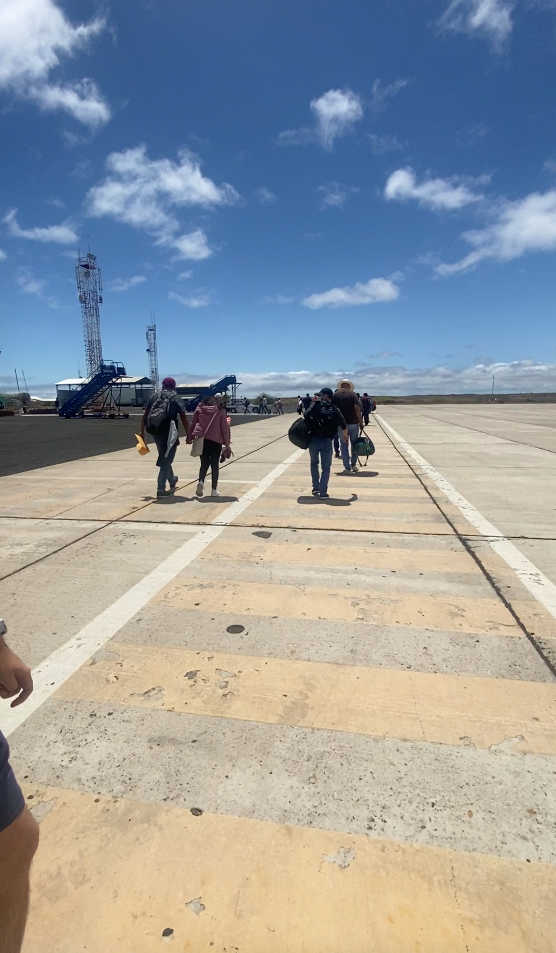Baltra Island is often the first piece of Galapagos that travelers encounter. Stepping off the plane, we felt the excitement set in as we arrived in this unique landscape. Baltra is one of two main entry points to the Galapagos, with an airport that simplifies travel logistics for those eager to explore the islands.
In this post, I’ll share our experiences on Baltra Island, offering practical tips and insights for anyone planning their own journey here.
Planning your dream Galapagos adventure? Start it right with expert guidance! Get a FREE personalized trip quote to ensure a seamless arrival, tailored island-hopping itinerary, and unforgettable experiences. Your booking supports this blog and helps local Galapagos communities thrive.
Plan perfect trip to Ecuador & Galapagos
I spent countless hours researching everything about traveling to Ecuador, and I created this blog for fellow travel enthusiasts who want the best, most reliable information. But if you want to save time, we’ve partnered with the top local agency to plan your dream trip.
Where Is Baltra Island Located?
Baltra is conveniently located in the Galapagos archipelago’s central region. It is positioned to the north of Santa Cruz island.
Baltra Island Facts
- Baltra Island was initially named South Seymour Island in honor of Lord Hugh Seymour, a prominent British Royal Navy officer in the 18th century.
- Unlike most Galapagos Islands, Baltra is not a volcano’s crater. It is an “uplifted island,” a section of land submerged before volcanic activity on nearby Santa Cruz Island altered the undersea geology.
- Baltra is arid, with saltbush, prickly pear cactus, and Palo Santo trees dominating the vegetation on the island.
- Franklin Delano Roosevelt visited the Galapagos Islands aboard the USS Houston in the 1930s. The US government was planning to establish a Pacific air base to safeguard the western approach to the Panama Canal.
- The military base was built in 1942 and played a significant role during World War II.
- The island is still an official Ecuadorian military base, with Navy and Air Force commands.
- Baltra islands’ Seymour Airport (GPS) is the first green airport in the world. It serves as one of the primary gateways to the Galapagos archipelago.
How To Get to Baltra Island?
To reach Baltra Island, flying is the only option, with daily flights available from mainland Ecuador or another Galapagos island. Avianca and LATAM are the two airlines servicing Seymour Airport on Baltra, with most flights departing from either Guayaquil or Quito.
We opted for a direct flight from Quito via Avianca, wanting to skip any layovers, and it was a smooth journey of around two hours. The feeling of anticipation as we landed on this small island was undeniable—it was our official welcome to the Galapagos!
What To Do on Baltra Island
Baltra Island is purely a gateway to the Galapagos, with no activities or attractions to linger over. Most visitors, like us, land here and make their way straight to Santa Cruz Island, where Puerto Ayora, the primary tourist hub, awaits with its lively ambiance and ocean views.
After we landed, we found a small café across from the airport, perfect for a quick coffee to recharge after our flight. A couple of gift shops are also conveniently located nearby for those last-minute souvenirs, a nice touch as we thought about our return journey.
Where To Stay on Baltra Island?
There are also no hostels or accommodations on Baltra Island. Most lodgings are also stationed in Puerto Ayora, Santa Cruz.
How To Get to Puerto Ayora, Santa Cruz From Baltra Island?
After touching down on Baltra Island, we quickly hopped on the “Lobito” bus, which takes you to the Itabaca Channel. With buses leaving every ten minutes, it was easy to find one, especially in such a compact airport. Tickets are sold at a small booth just across from the bus area and cost $5 per person.
The bus ride to the Itabaca Channel took only about 10-15 minutes, with views of arid landscapes and volcanic rock reminding us we were in the unique environment of the Galapagos. Once at the channel, a friendly local pointed us toward the water taxis. The ride cost $1 each, and in just 5 minutes, we arrived at Santa Cruz Island.
From there, we had two choices to reach Puerto Ayora, where our hostel awaited: either take another bus or grab a taxi. Since Puerto Ayora is about 45 minutes south, we decided to stick with the bus, though we noticed the taxis here are all white pickup trucks, mostly Toyota HiLux or Nissan Frontiers—a quirky detail that made the experience feel even more local!
How To Get Back to Baltra Island From Puerto Ayora?
To get to the Itabaca Channel from Puerto Ayora, you have two main options: a bus or a taxi. Buses have set schedules, so checking the timing beforehand is wise. Since we didn’t want to risk missing our flight, we decided to take a taxi, which set us back over $25—so it’s a good idea to budget for this if you’re in a hurry.
At the channel, we discovered that there are both government-operated and private water taxis. Private taxis charge a bit more, at $2 per person. It was helpful to know these small details in advance to plan our expenses.
Once across the channel, we boarded the bus to the airport terminal, the same setup we used upon arrival, costing $5 each. Little logistical nuances like these helped us navigate smoothly and manage our budget efficiently while in the Galapagos.
Don’t leave your Galapagos journey to chance—let trusted local experts handle the logistics. Get a FREE trip quote for a stress-free start and perfectly curated itinerary. Your support not only helps this blog but also empowers local Ecuadorian agencies and communities!
Why We Chose Baltra Island as Point of Entry to the Galapagos
As you may already know, the Galapagos Islands have two main airports: one on Baltra Island and another on San Cristobal Island. When planning our trip, we researched both options and found that each has its advantages and challenges.
Arriving in Baltra, while the more common choice, involves a bit of logistical juggling to get to Santa Cruz. From the airport, you need to take a bus, a water taxi, and another bus or taxi to reach Puerto Ayora, making it a slightly more time-consuming and costly option.
On the other hand, flying into San Cristobal offers a more straightforward arrival, with accommodations and key sites close to the airport. But since San Cristobal is located further east, reaching Isabela Island from there involves two ferry rides, which can be time-intensive.
Ultimately, the best airport for your Galapagos journey depends on your itinerary and preferences. Baltra may be ideal if your stay is centered around Santa Cruz and Isabela. But if you want a simpler arrival experience or plan to explore San Cristobal extensively, flying directly into San Cristobal could be the better choice. Balancing travel costs, time, and convenience made a big difference in our own trip planning.
Have questions about your upcoming Galapagos trip? Join my Galapagos Reddit community and ask other travelers who recently visited the islands. Get up-to-date tips, real experiences, and honest advice from other travelers (I ban tour agencies and resellers).

Planning trip to Galapagos Islands?
My wife and I spent two weeks on these magnificent islands, visited nearly every possible tour, and explored as much as we could. I shared all the important details in my comprehensive Galapagos Islands Travel Guide, where I cover everything you need to know about planning a trip to the Galapagos.
Galapagos Islands travel might surprise you with extra fees to enter the islands, the complicated logistics between islands, booking tours, and knowing which spots are free to explore and which ones are not. I’ve covered it all in this Galapagos Travel Guide.
Also, if you’re planning a trip to the Galapagos, make sure to use my link for discounted hotel prices via Booking.com. It really helps support my blog!
Conclusion
Setting foot on Baltra Island truly felt like the start of something special! Even though Baltra itself is more of a gateway than a destination, the journey to Santa Cruz held its own magic. The landscape was rugged and raw, with cactus-studded terrain stretching out under the vast sky, giving us a real sense of arriving somewhere wild and unique.
On our bus ride down to the Itabaca Channel, we kept our eyes peeled, and sure enough, we were rewarded with some unexpected wildlife sightings! A couple of land iguanas casually lounged by the roadside, blending into the landscape in a way that made us feel like we were stepping into a David Attenborough special. These small encounters were the perfect taste of the amazing wildlife awaiting us in the Galapagos. The journey felt less like a transfer and more like an immersive welcome to the islands.
Keep your eyes wandering as you can also get sightings of the ruins of US Air Force history and the uniqueness of Balta Island’s structure.
Plan perfect trip to Ecuador & Galapagos
I spent countless hours researching everything about traveling to Ecuador, and I created this blog for fellow travel enthusiasts who want the best, most reliable information. But if you want to save time, we’ve partnered with the top local agency to plan your dream trip.








